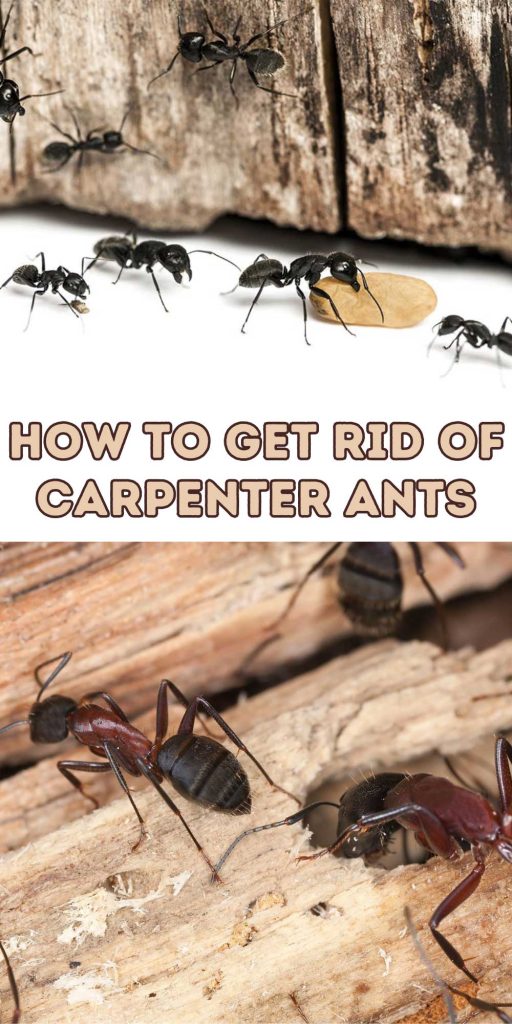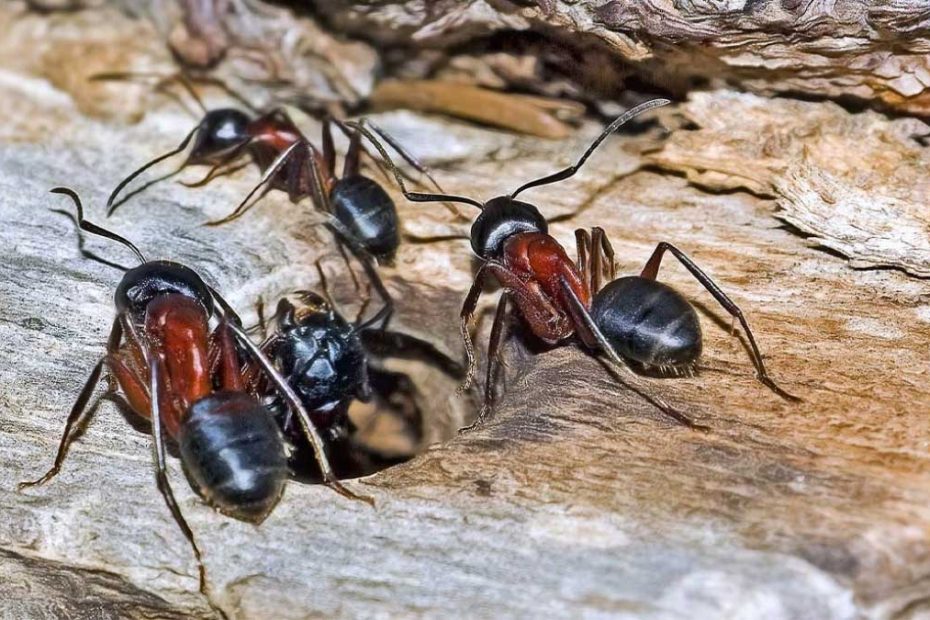Carpenter ants can turn your home into a nightmare, gnawing through wood and causing structural damage. Unlike termites, these pests don’t eat wood; they excavate it to build their nests, which can lead to costly repairs if not addressed promptly. Knowing how to get rid of carpenter ants effectively is crucial for maintaining your home’s integrity and peace of mind.
You’ll need a multi-faceted approach to tackle these resilient insects. From identifying the signs of an infestation to implementing targeted treatments, understanding the best strategies will help you reclaim your space. In this text, we’ll guide you through proven methods to eradicate carpenter ants and prevent them from returning.
Key Takeaways
- Early Identification: Recognizing signs of carpenter ant infestations, such as sawdust-like debris and rustling noises, helps prevent extensive structural damage.
- Prevention Strategies: Maintain cleanliness, seal entry points, and reduce moisture to deter carpenter ants from entering your home.
- Natural Remedies: Essential oils, boric acid, and diatomaceous earth offer eco-friendly solutions to repel and eliminate carpenter ants.
- Chemical Solutions: Insecticide sprays and bait systems effectively target carpenter ant colonies for quick and thorough eradication.
- Professional Help: Hiring pest control professionals ensures specialized treatment and follow-up visits for stubborn infestations.
- Long-Term Maintenance: Regular inspections, timely structural repairs, and strategic landscaping help prevent future carpenter ant problems.

Understanding Carpenter Ants
Understanding carpenter ants is essential for effective control. These ants can cause significant damage to your home if left unchecked.
What Are Carpenter Ants?
Carpenter ants are large ants that nest in wood. Here’s a breakdown of key terms:
- Scientific Name: Camponotus spp.
- Appearance: Black or brown, 0.25 to 0.5 inches long.
- Habitats: Wood structures, damp or decaying wood.
- Diet: Insects, plant juices, honeydew from aphids.
Signs of a Carpenter Ant Infestation
Identifying an infestation early can prevent extensive damage. Look for these signs:
- Sawdust-like Debris: Frass, a byproduct of wood excavation.
- Noise: Rustling sounds inside walls, especially at night.
- Visible Ants: Large ants, especially in kitchens and bathrooms.
- Damage: Hollow sounds when tapping wooden structures.
Why Carpenter Ants Are a Problem
Carpenter ants’ nesting behavior is destructive. They don’t consume wood but carve out galleries to build nests, which weakens structural integrity. Addressing the issue promptly minimizes repair costs and structural damage.
Prevention Methods
Taking proactive measures prevents carpenter ants from becoming a problem in your home. This section explores effective prevention strategies.
Maintaining Cleanliness
Keeping your environment clean deters carpenter ants from nesting and searching for food. Focus on these areas:
- Kitchen: Store food in airtight containers and promptly clean crumbs and spills.
- Garbage: Securely cover trash bins and regularly dispose of waste.
- Pet Food: Do not leave pet food out overnight.
Sealing Entry Points
Blocking potential entry points stops carpenter ants from accessing your home. Inspect and seal:
- Cracks and Gaps: Fill gaps in walls, doors, and windows using caulk.
- Pipes and Wires: Check areas where pipes and wires enter your home and apply sealant.
- Door Sweeps: Install door sweeps on exterior doors to close gaps.
Reducing Moisture
Carpenter ants thrive in moist environments, so reducing moisture helps prevent infestations:
- Plumbing: Fix leaking pipes and faucets promptly.
- Ventilation: Ensure proper ventilation in areas prone to humidity, like bathrooms and basements.
- Gutters: Keep gutters clean and ensure downspouts direct water away from the house.
Adhering to these methods keeps carpenter ants at bay and protects your home from infestation.
Natural Remedies
You can use natural remedies to get rid of carpenter ants effectively. These solutions are eco-friendly and safe for your home environment.
Using Essential Oils
Essential oils offer a non-toxic way to repel and eliminate carpenter ants.
Peppermint Oil:
- Mix 10-15 drops with water and spray around entry points.
- Reapply every few days for continued protection.
Tea Tree Oil:
- Combine 10 drops with water and a few drops of dish soap.
- Apply the mixture to ant trails and nests.
Cinnamon Oil:
- Mix 10-15 drops with water.
- Spray areas where ants are commonly seen.
Boric Acid
Boric acid disrupts the digestive system of carpenter ants, leading to their elimination.
Preparation:
- Mix half a teaspoon of boric acid with 1 cup of sugar and water.
- Soak cotton balls in the mixture.
Application:
- Place the soaked cotton balls near ant trails.
- Replace the cotton balls every few days until the ants are gone.
Diatomaceous Earth
Diatomaceous earth (DE) is a fine powder that dehydrates and kills ants upon contact.
- Use only food-grade DE for safety.
- Sprinkle a thin layer around suspected entry points and nests.
- Reapply after rain or heavy moisture.
- Regularly check and refresh the DE layer for continued effectiveness.
Chemical Solutions
Chemical solutions are effective for eliminating carpenter ants quickly and thoroughly. These methods use formulated products that target and kill the ants, helping to control and prevent infestations.
Insecticide Sprays
Insecticide sprays offer a quick way to kill carpenter ants on contact. These sprays contain active ingredients designed to target ants’ nervous systems, providing immediate results.
- Ingredients: Look for sprays containing pyrethroids, bifenthrin, or deltamethrin. These chemicals are effective against carpenter ants.
- Application: Spray directly on visible ants and trails. For best results, spray around potential entry points like door frames, window sills, and baseboards.
- Residual Effect: Some sprays offer a residual effect, continuing to kill ants for weeks after application. Ensure the product has a long-lasting impact for prolonged protection.
Ant Baits
Ant baits work by attracting carpenter ants to consume poisoned food and carry it back to their nest, eventually killing the entire colony.
- Active Ingredients: Effective baits often contain hydramethylnon, fipronil, or borax.
- Placement: Place baits near ant trails, kitchens, bathrooms, and other high-traffic areas. Ensure they are inaccessible to pets and children.
- Patience: Baits work slower than sprays but are more effective in eliminating ant colonies. Give the baits several days to weeks to show results.
Professional Pest Control
If chemical solutions seem daunting or ineffective, consider hiring a professional pest control service. Experts can provide specialized treatments tailored to your home’s specific infestation.
- Assessment: Professionals conduct thorough inspections to locate nests and assess the infestation level.
- Customized Treatments: Services may include advanced treatments like perimeter sprays, foam injections, or dust-based applications targeting hard-to-reach areas.
- Follow-Up: Reliable services offer follow-up visits to ensure the problem is resolved and help prevent future infestations.
By using these chemical solutions, you can efficiently tackle carpenter ant infestations and protect your home from further damage.
Long-term Maintenance
Ensuring the ongoing protection of your home from carpenter ants requires consistent maintenance and proactive strategies. You can prevent future infestations by incorporating regular inspections, addressing structural repairs, and utilizing smart landscaping tips.
Regular Inspections
Regular inspections allow you to detect signs of carpenter ants before they become a more significant problem.
- Frequency: Conduct inspections quarterly to stay on top of any potential issues.
- Signs to Look For: Notice frass (sawdust-like debris), rustling noises, visible ants, and hollow-sounding wood when tapped.
- Inspection Areas: Focus on basements, attics, kitchens, bathrooms, and any area with woodwork or moisture.
Inspections shouldn’t be limited to these signs alone. Be vigilant about any unusual activity in and around your home.
Structural Repairs
Structural repairs maintain the integrity of your home and eliminate potential nesting sites.
- Address Damage: Repair any damaged or decaying wood promptly.
- Seal Cracks: Use caulk or other sealants to fill in gaps and prevent entry points.
- Improve Ventilation: Ensure proper airflow in attics, basements, and crawl spaces to reduce moisture.
Ignoring structural damage exacerbates ant problems and compromises your home’s stability.
Landscaping Tips
Strategically world around your property to deter carpenter ants.
- Trim Vegetation: Keep trees and shrubs trimmed back from your house.
- Remove Dead Wood: Clear away any fallen branches, logs, and stumps from your yard.
- Maintain Mulch: Keep mulch at least 6 inches away from your home’s foundation.
Effective landscaping minimizes the chances of carpenter ants finding a hospitable environment near your home.
By adhering to these long-term maintenance strategies, you can create an environment that is less hospitable to carpenter ants, ensuring your home remains safe and secure.
Conclusion
Getting rid of carpenter ants is crucial to maintaining your home’s structural integrity. By understanding their behavior and characteristics, you can identify and address infestations effectively. Implementing preventive measures, such as maintaining cleanliness, sealing entry points, and reducing moisture, helps keep these pests at bay.
Natural remedies like essential oils, boric acid, and diatomaceous earth offer eco-friendly solutions, while chemical treatments provide quick and thorough elimination. If needed, professional pest control services can offer tailored treatments to ensure the problem is fully resolved.
Consistent long-term maintenance and regular inspections are key to preventing future infestations. By following these strategies, you can protect your home from carpenter ants and maintain a safe, secure living environment.
Frequently Asked Questions
What are carpenter ants?
Carpenter ants, scientifically known as Camponotus spp., are ants that build their nests by excavating wood. They are typically black or brown and range from 0.25 to 0.5 inches long.
How do carpenter ants damage my home?
Carpenter ants carve out galleries in wooden structures to build their nests, which can weaken the structural integrity of your home and lead to expensive repairs if not addressed.
What are the signs of a carpenter ant infestation?
Signs of an infestation include sawdust-like debris (frass), rustling noises inside walls, visible ants in kitchens and bathrooms, and hollow sounds when tapping wooden structures.
How can I prevent carpenter ants in my home?
Prevent infestations by maintaining cleanliness, sealing entry points, and reducing moisture through prompt plumbing repairs and proper ventilation.
What natural remedies work against carpenter ants?
Effective natural remedies include essential oils like peppermint, tea tree, and cinnamon, as well as boric acid and diatomaceous earth (DE) to disrupt and kill ants.
Are chemical solutions effective for eliminating carpenter ants?
Yes, insecticide sprays and ant baits can be effective. Look for products containing pyrethroids, bifenthrin, or deltamethrin for quick results, but consider professional pest control services if needed.
When should I hire professional pest control for carpenter ants?
Consider hiring professionals if natural and chemical solutions prove ineffective or if you want tailored treatments and follow-up visits to ensure the problem is resolved.
How often should I inspect my home for carpenter ants?
Regularly inspect your home every quarter, focusing on areas like basements, attics, and kitchens to detect signs of carpenter ants early.
What long-term maintenance can prevent carpenter ant infestations?
Long-term strategies include regular inspections, structural repairs, and smart landscaping tips like trimming vegetation and removing dead wood to create a less inviting environment for carpenter ants.
